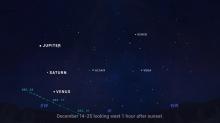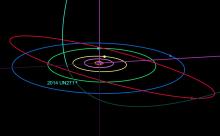Listen to today's episode of StarDate on the web the same day it airs in high-quality streaming audio without any extra ads or announcements. Choose a $8 one-month pass, or listen every day for a year for just $30.
You are here
Double Showers
The Lyrid meteor shower should be at its best tonight, after midnight. Under dark skies, away from city lights, you might see a few dozen “shooting stars” in all.
The Lyrids are spawned by Comet Thatcher. This ball of ice and rock orbits the Sun once every 415 years. It sheds grains of solid material on each orbit. Earth passes through this trail of debris every April, creating the meteor shower.
Last year, a second shower was taking place at the same time as the Lyrids. It wasn’t much — tracking cameras detected about a dozen meteors. But it suggests that a big comet could be headed our way.
The shower was called the 15-Bootids. It was detected by cameras in Europe and the Middle East. Scientists used images from multiple cameras to plot the paths of these meteors. That allowed them to trace their original orbits around the Sun.
From that, the scientists found that the bits of debris might have come from a bright comet that last visited the inner solar system in the year 539.
The speed of the meteors suggests the comet is big — perhaps 10 miles in diameter. Because its trail crosses Earth’s orbit, it could be a threat to hit our planet. And the presence of the shower suggests the comet could be getting close.
The 15-Bootid shower isn’t expected to be seen again until 2027. In the meantime, though, check out the Lyrids. Find a dark, safe skywatching location, far from city lights, and look up — for fireworks from a comet.
Script by Damond Benningfield





